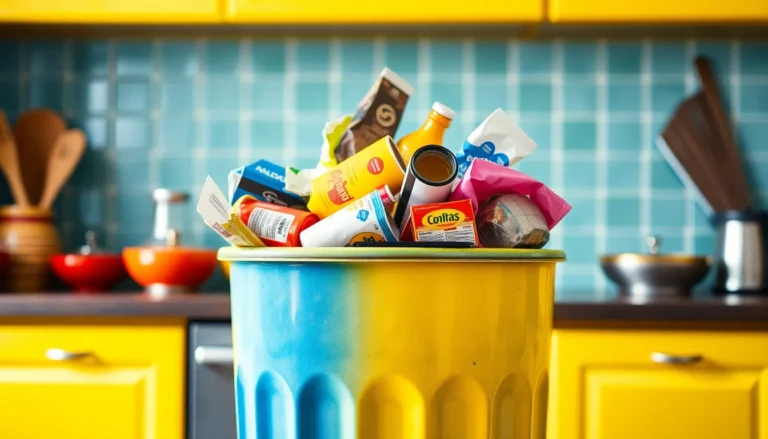Ever wondered what really goes on inside a trash can? It might seem like a mundane topic, but peek inside, and you’ll discover a world teeming with surprises. From forgotten snacks to oddball treasures, the inside of a trash can tells a story of daily life that’s both humorous and eye-opening.
Table of Contents
ToggleOverview of Trash Cans
Trash cans serve essential functions in homes, offices, and public spaces. They collect waste, helping maintain cleanliness and order. Various types of trash cans exist, including kitchen bins, outdoor waste containers, and recycling receptacles. Each type features distinct designs tailored for specific waste materials.
A common kitchen trash can often contains food scraps, packaging, and other discarded items. In contrast, outdoor trash cans may hold larger debris, such as yard waste, broken furniture, or discarded outdoor gear. Recycling bins promote environmental responsibility by separating recyclables, including paper, plastics, and metals.
Materials used for trash can construction vary greatly. Common options include plastic and metal, with each material offering specific benefits. Plastic cans often weigh less and resist rust, while metal cans provide durability and often appear more aesthetically pleasing.
The design of trash cans can significantly influence waste management practices. Some models include features like foot pedals for hands-free operation or locking lids to deter pests. Innovative designs such as sensor-operated lids enhance user convenience and promote hygiene.
Understanding the waste inside a trash can enhances awareness of consumption patterns. Commonly found items, including food wrappers and beverage containers, reflect daily habits. Identifying patterns in waste production can lead to improved recycling efforts and reduced clutter.
Regular emptying of trash cans is necessary for maintaining a clean environment. Accumulated waste can produce unpleasant odors and attract pests. Adopting a consistent waste disposal routine helps achieve cleanliness and a more organized living space.
Common Types of Trash Cans

Trash cans come in various types, each suited for specific waste management needs. Understanding these types helps improve recycling habits and cleanliness.
Kitchen Trash Cans
Kitchen trash cans deal with daily household waste. They often feature a foot pedal for hands-free operation and touchless sensors that enhance convenience. Common materials include plastic and stainless steel, which ensure durability. Many kitchen bins come with built-in odor filters to reduce unpleasant smells. Their sizes typically range from 5 to 13 gallons, accommodating different kitchen layouts. Some models have compartments for recycling, making them versatile for eco-friendly practices.
Outdoor Trash Cans
Outdoor trash cans serve in parks, streets, and commercial areas. Durability proves essential, so most designs utilize heavy-duty plastic or metal. A wide variety of sizes exists, from small 32-gallon bins to larger communal units. These containers often incorporate features such as locking lids to deter wildlife. Some outdoor models focus on recycling and separate waste streams. When placed strategically, they encourage responsible disposal and maintain cleanliness in public spaces.
What You Might Find Inside of a Trash Can
Trash cans often contain a variety of waste, showcasing remnants of daily routines and habits. From organic waste to non-recyclable items, the contents reflect both individual choices and broader waste management challenges.
Organic Waste
Organic waste typically consists of food scraps, garden clippings, and other biodegradable materials. Discarded fruits and vegetables, in particular, accumulate quickly in kitchen bins. Additionally, coffee grounds and eggshells are common contributors to the organic waste category. This type of waste decomposes over time, offering opportunities for composting and enriching soil. Food packaging that’s compostable also falls into this group. Understanding the presence of organic waste encourages more sustainable disposal practices.
Non-Recyclable Items
Non-recyclable items usually include plastics that cannot be repurposed, such as single-use utensils and polystyrene containers. These materials generally take years to decompose and contribute to landfill overcrowding. Additionally, items like greasy pizza boxes and certain plastics may confuse recycling processes. Old electronics and batteries also often find their way into trash cans, posing environmental hazards. Recognizing non-recyclable items can guide individuals in making informed waste disposal choices. It promotes the necessity of reducing such items through alternatives and mindful purchasing behaviors.
The Importance of Proper Trash Disposal
Proper trash disposal plays a vital role in maintaining cleanliness and public health. Understanding the types of waste disposed of in trash cans can significantly improve recycling rates and waste management practices. Individuals sorting items before throwing them away helps reduce contamination in recycling streams.
Organic waste, such as fruit peels and vegetable scraps, is often found in household trash cans. Composting this type of waste provides an environmentally friendly alternative and enriches soil quality. By recognizing organic materials, households can minimize landfill waste and contribute to sustainable practices.
Non-recyclable items, including single-use plastics, frequently clutter trash cans. These items contribute to growing landfill issues and can pose serious environmental hazards. Discouraging the use of non-recyclable materials supports a cleaner environment and encourages the adoption of reusable products.
In public spaces, maintaining clean and well-organized trash disposal systems reduces littering. Implementing designated recycling and waste bins encourages responsible disposal habits. Municipalities can invest in clear signage to guide people in proper waste separation.
Regularly emptying trash cans prevents unpleasant odors and pest infestations. It’s crucial to establish a schedule for emptying both indoor and outdoor bins to maintain hygiene. Educating communities on the importance of proper trash disposal can lead to enhanced overall cleanliness.
Effective waste management practices rely on each individual making informed disposal choices. Understanding the impact of one’s waste on the environment fosters mindful purchasing behaviors. Prioritizing sustainable practices can ultimately lead to healthier communities and a cleaner planet.
The inside of a trash can offers a unique glimpse into daily life and consumption habits. By examining its contents individuals can gain valuable insights into their waste management practices. This awareness not only fosters better recycling efforts but also encourages more sustainable disposal methods.
Understanding the significance of different types of trash cans and their specific functions can lead to improved cleanliness and hygiene in both personal and public spaces. Regular maintenance and education on proper disposal techniques are essential for promoting responsible habits. Ultimately, a mindful approach to waste can contribute to a cleaner environment and a healthier community.










